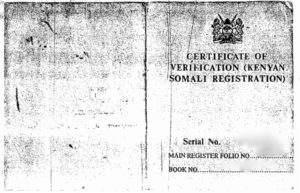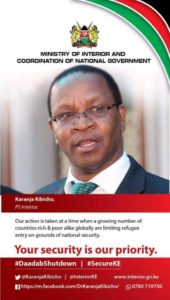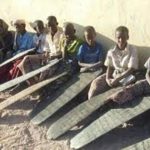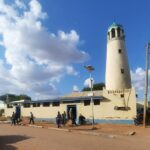Kenyans must apply for an ID card within 90 days of their eighteenth birthday. Yet in the north-east – and on the coast – securing the all-important ID is a prolonged ordeal. Instead of applying individually, people must secure a place on a list compiled by the location chief and local elders and await the infrequent visit of a vetting team. Even after vetting and receiving ‘waiting cards’, applicants sometimes do not receive their IDs for many months or even years.
 By Emma Lochery
By Emma Lochery
In early May 2016, Kenya’s government announced the closure of Dadaab refugee camp complex, located around 100 kilometres from the Somali border and home to over 300,000 people. Government statements framed Dadaab as a space where Al Shabaab operates with ‘an alarming degree of freedom’. Officials claimed Kenya was facing an ‘existential terrorist threat’ with insufficient resources as international donors left promises to Kenya unfulfilled.
The government closed the Department of Refugee Affairs and established a taskforce to oversee the camps’ closure. They announced a plan to resettle refugees in Jubaland, the regional state over the border in Somalia, formed after the 2011 Kenyan invasion. By late August 2016, the government softened its stance on immediate closure of the camps, but remained focused on refugee verification and repatriation.
Kenyan government rhetoric on the camp closure posits a clear division between Kenyan and Somali, refugee and citizen – and presents one straightforward option: move people to the territory where they ‘belong’.
Reality is not that simple. Potential returnees navigate complicated terrains of citizenship and belonging. How will people be protected amidst ongoing conflict? What political status will they have? In Jubaland the question of who is a citizen with rights to political representation, land, and services remains unsettled.
Blurred Lines
Who belongs is also a fraught question on the Kenyan side of the border. The attempt to push Somali refugees out of Kenya is happening in a context where the line between refugees and citizens, while being the target of violent enforcement, is blurred.
Over the last three decades, with legal pathways to settlement and residence in Kenya closed off, refugees with sufficient resources have used available means and connections to secure Kenyan identity cards. These documents enable people to register a business, access financial institutions, invest in property, and travel more easily. Meanwhile, in search of rations or resources, some residents of north-eastern registered in the camps as refugees: Dadaab is an economic centre in a very poor part of Kenya. This crisscrossing of the line between citizen and non-citizen reflects people constructing lives in tight corners.
However, the blurring of the line between citizen and alien is also the product of how the Kenyan state has historically worked to mark its sovereignty over northern Kenya. Although the Kenyan state’s rhetoric focuses on its duty to secure the border and demarcate a clear line between Kenyan citizens on the one hand and refugees and migrants on the other, the government’s actions have served to blur the very lines it claims to draw, making citizens and refugees alike more vulnerable. For decades, the Kenyan government has treated North-Eastern Province as a place apart, where citizenship and membership must be verified and bought. They have policed the border of the nation through violence against Somali communities, creating a graduated citizenship where some people’s access to citizenship is more precarious than others.
 Internal Borders
Internal Borders
The logic of this categorical precarity reaches back to British colonial isolation of the Northern Frontier District, when numerous restrictions were put on the movement of people. The subsequent civil war in north-eastern Kenya in the 1960s, labelled the Shifta War (‘bandit’ war) by the Kenyan government, re-entrenched colonial marginalisation. Faced with the rebellion by Somali militants in the north-east of the newly independent country, the Kenyan forces carried out screening exercises and forced villagisation. Despite the end of the war in 1967, the North Eastern Province (NEP) and neighbouring districts remained under emergency rule until 1991, characterized by insecurity and brutal exercises of collective punishment. This history sheds a long shadow: the province was marginalised in terms of resources and infrastructure.
A stark demonstration of Somalis’ precarious access to citizenship in Kenya is the politics surrounding the granting of identity cards. As ‘citizenship technologies’, identity cards grant access to rights and services. However, the process through which they are acquired inscribes difference – some people’s rights are more secure than others.
Kenyans must apply for an ID card within 90 days of their eighteenth birthday. Yet in the north-east – and on the coast – securing the all-important ID is a prolonged ordeal. Instead of applying individually, people must secure a place on a list compiled by the location chief and local elders and await the infrequent visit of a vetting team. Even after vetting and receiving ‘waiting cards’, applicants sometimes do not receive their IDs for many months or even years.
This vetting has been accompanied by routine police raids in Eastleigh and Somali-dominated urban areas across Kenya including large-scale round-ups like Operation Usalama Watch in 2014. These exercises are the latest iteration of historical practices through which the Kenyan state has sought to police Somali identity. A large-scale screening exercise was threatened during the Ogaden War in the late 1970s; that screening exercise became reality in 1989 as Somalis across Kenya had to verify their citizenship before panels of elders. Pink verification certificates were issued to those who could prove they were ‘indigenous’ to Kenya; those who could not were to be detained and deported.
As the Kenyan government repeatedly urges mass repatriation exercises, it is important to reflect on the ways the Kenyan state has historically policed citizenship and sought to reinforce its sovereignty over north-eastern Kenya. The government has framed Dadaab as a space that can be removed and reinserted back into Somalia – and Somali refugees as people who can be reinserted into a separate society across the border. This framing ignores the reality of the frontier and the ongoing and complicated construction of citizenship and belonging on both sides. It also builds on a long history of bordering processes that sacrifice human welfare for the principle of state sovereignty.











